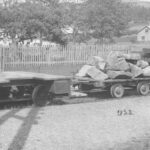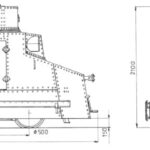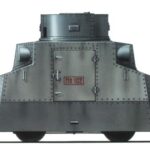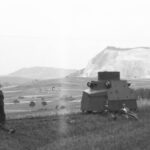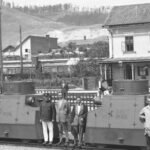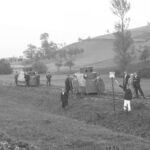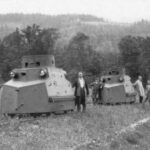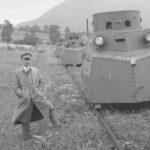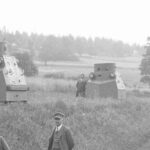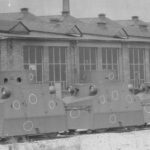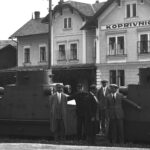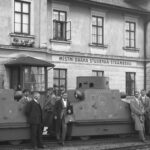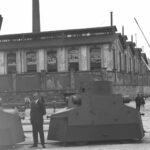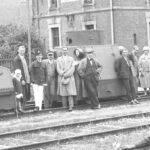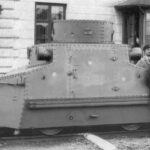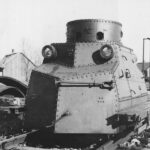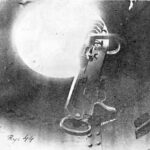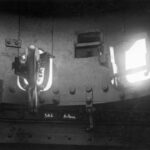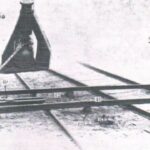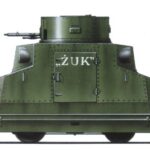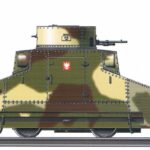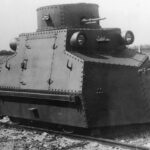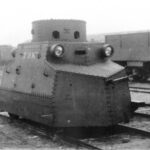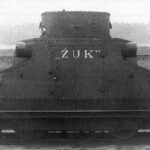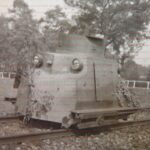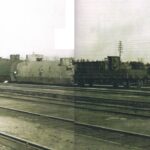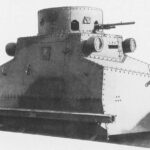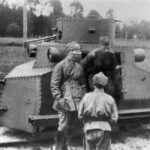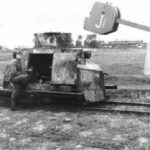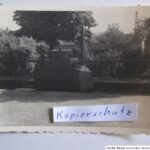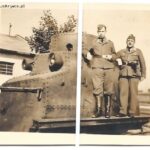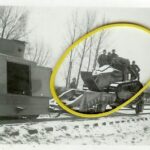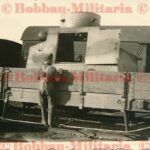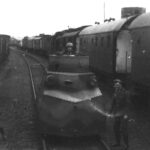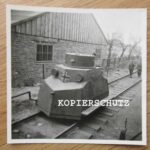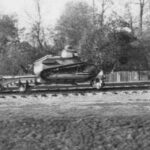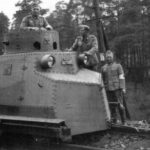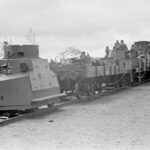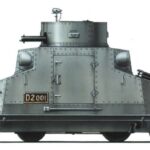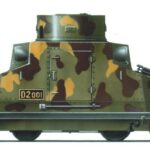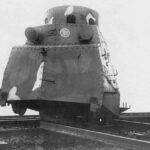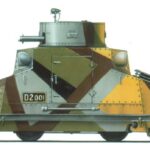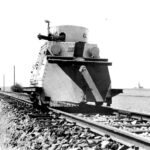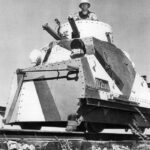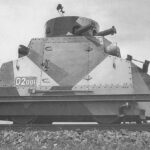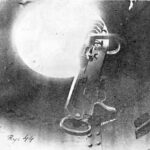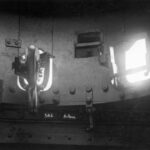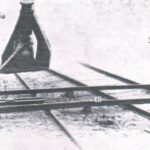The Tatra T18 model is here
History
The armoured draisine Tatra T18 was designed in 1925 in Czechoslovakia, in Kopřivnická vozovka (later Ringhoffer-Tatra) works, basing upon a chassis of a cargo draisine T14. It was the only armoured draisine of this firm, apparently developed specially for Poland, on initiative of Polish Tatra Auto Warszawa dealership, who was aware, that Polish Army was interested in obtaining such vehicles. The earliest sketch of a chassis, modified with two driver posts, was dated on 17 February 1925. In summer, a body design was developed, initially with rounded front and rear, soon replaced with more technological flat angled panels. On 5 September 1925 Poland ordered six armoured draisines, straight from a drawing board. The vehicles were delivered in November 1926. They had factory numbers 5545 to 5550. In Polish service they were known simply as « Tatra » armoured draisine (drezyna pancerna). Only on 24 December 1926, the Czechoslovak Army ordered one armoured draisine (pancéřová drezina), built in 1927, bearing a railway stock number D2.001 (factory nmber 7077). They were the only complete T18 draisines built.
The vehicles did not fulfil expectations of the Polish Army, though. Already in January 1927 their engines were found too weak, and their mobility was evaluated low, with slow acceleration. Nevertheless, chassis for further nine vehicles were ordered on 4 April 1927, without armoured bodies (one chassis costed $1980). Armoured bodies were to be made in Poland by the CWS (Centralne Warszaty Samochodowe) workshops. Armoured plates were first ordered from Italian Ansaldo works, but it was cancelled due to inaccuracies of the first batch. Then, they were ordered from an iron works in Sosnowiec, Poland, but it was apparently cancelled as well, and no additional draisines were armoured in Poland. The technical requirements for bodies were approved only in August 1931. They called for strengthening of the armament, using Ursus type turret (as in wz. 29 armoured car, with one 37 mm SA Puteaux gun and one wz. 25 machine gun), and improving observation conditions, with periscope visors for drivers and two additional periscope side visors. It was not proceeded further, because Tatra draisines were considered obsolete by that time and were to be replaced with rail-and-ground R and TK draisines. According to newest research by A. Jońca, three chassis were used to replace worn-out ones in late 1930s, and one armoured body was reportedly made in Poland, used for a rehaul of one draisine. There is no information about the rest of chassis.
In Polish Service
Polish draisines were at first sent to the Armoured Trains’ Training Battalion in Jablonna near Warsaw, reorganized in 1927. In 1930s they were used for training in both existing armoured train units. The Tatras were assigned to four armoured trains of the 1st Armoured Train Unit in Legionowo near Warsaw and two trains of the 2nd Unit in Niepołomice near Kraków. During factory trials and in early period of service they carried numbers « № 101 » to « № 106 » (possibly Polish inventory numbers), but they were soon removed. Some of them had own names painted in late 1920s, such as « Osa » (Wasp) and « Żuk » (Beetle), without numbers. From 1936-1937 they were camouflaged in a standard three-colour pattern of Polish vehicles, with irregular big airbrushed patches of greyish sand and dark brown upon a basic olive green colour. Earlier they were painted in an uniform colour, probably dark green. There is however known an official photo of the draisine « Osa » in Polish camouflage from early 1930s. In 1939 they carried no markings, apart from Polish State Railways (PKP) eagle emblem on side doors, painted over in a camouflage colours as well.
In September 1939, they were used only with armoured trains Nr. 15 (« Śmierć ») and Nr. 13 (« Generał Sosnkowski »). Each of them had a platoon of two Tatras (Nr. 13 train also had two R draisines). One draisine of Nr. 15 train was destroyed by German anti-tank guns near Nasielsk on 5 September 1939, while leading a reconnaissance. The rest were apparently abandoned, possibly in a damaged condition (Nr. 13 train was bombed and destroyed on 10 September 1939 in Łochów, though its draisines remained intact). There are known photographs of one draisine of Nr. 13 train abandoned between Łochów and Małkinia, and the other unidentified captured one. There is no information on usage of remaining two Tatras from the 2nd Armoured Train Unit (one might have been withdrawn by the war).
In German Service :
At least one captured Tatra was used in German armoured trains Panzerzug 7 (in 1940-1941), then Panzerzug 1 (in 1941-1942). Details like covered headlights and a horn show, that it was the Czechoslovak draisine, seized by the Germans. In German service it was apparently fitted with an additional applique armour on ends and sides, and a radio with four masts and a clothes line aerial. As a compensation for increased weight, track switching devices were probably removed, and side rails were replaced with simple plank steps. It had no fixed weapons. With the Panzerzug 1 it took part in an early phase of an attack on the USSR, but soon it was withdrawn due to needs of a broad-gauge stock, when advanding farther east. All of Polish Tatra draisines were captured by the Germans, but their fate is not known. Each armoured train should have an own draisine, according to 1940 plans, but there aren’t known any other German trains using Tatras. Probably their weak engine discouraged the Germans from wider usage of this type.
In Czechoslovak service :
The only Czechoslovak Tatra T18 (no. D2.001) was used by the Czechoslovak Army for exercises. According to one photograph, it could be also used in a composition of an armoured train, seated upon a special flatcar. It was slightly damaged in a collision with an armoured train on 7 September 1930 (injuries only). During the Czechoslovak Army mobilization in September 1938, before Munich Agreement, it operated in Slovakia with the armoured train Nr. 4. It again collided with an ordinary locomotive on 22 November 1938 in Zvolen. During the German annexation of Czechia, it was captured on 15 March 1939 in a base in Milovice. From 1930s it was camouflaged in an interesting five-colour pattern of green, brown, ochre, grey and black, with sharp straight edges. Black and brown were used mainly for thick straight lines separating other colours. One draisine is known to have survived the war (probably the Czechoslovak one) – found in Czechoslovakia and briefly used by the Czechoslovak army after the war. It was withdrawn already in 1940s and its further fate is not known.
Description
The armoured draisine Tatra T18 was two-axle light rail vehicle. A chassis frame, riveted from steel profiles, was seated upon axles, sprung by helical springs. Axles were nested in ball bearings. In a middle of the frame, there was a tranversal air-cooled flat boxer engine, with a cooling fan and a mechanical gearbox (two gears in both directions). Only one (rear) axle was driven by a chain gear (it should be noted, that Polish military regulations claimed, that both axles were driven, what contradicts with Czech sources and plans – if it is true, maybe they were modified afterwards, although there has been no such information revealed). A fuel tank, 80 l capacity, was in the frame, behind front axle. Upon the frame there were also sandboxes to improve adhesion, operated by drivers (two according to Czech monograph, pouring sand only before left front wheel in drive direction, or four according to Polish regulation).
The body was made of armour sheets, screwed to a body frame. On a roof, there was a cylindrical turret, of 115 cm internal diameter and 46 cm height, running upon a ball bearing. In both hull sides there were rectangular entrance hatches. A small round hatch (50 cm diameter) was in the turret’s roof. The draisine had doubled driver posts, on both ends, slightly to the right of a longitudinal axis. Each driver had only one vision slot before him, covered with an armoured hatch. There were no other vision devices in the hull, including none for side observation. Only in the turret there were four vision slots all around, covered with hatches. As a result, observation conditions for the crew were apparenlty poor. Each driver had three pedals (acceleration, clutch and brake), a crank of a main brake to the right, and a gear stick and throttle and ignition levers to the left. The chassis frame was covered with a wooden floor, on which drivers sat (the floor was 67 cm above rails). There are no details, how the drivers’ seats were made; probably they had pads with no back support. A central section of the floor was removable for engine access. Above the central section there was a rotating gunners’ seat on a tripod. There was also a small flap in the floor, on one side, for starting of the engine with a crank from the inside. It is not clear how a lowered floor under drivers’ legs was made (it is not indicated on factory sketches) – there might have been a partial 5 mm armoured plate under part of the vehicle, screwed to the frame from an underside, as is suggested by Polish regulation.
(The Polish military regulation claimed generally, that the draisine had 5 mm armoured floor on a whole underside, with cut-outs for wheels, but there is no such mention in Czech monograph, and moreover, such floor would demand at least a big opening in a centre for jack arms and engine cooling, and also openings for axle suspension racks and their longitudinal joints, and it would also make a chassis maintenance difficult. It is possible, that the information was partially true, and the draisine had partial armoured floor, especially in ends. As we have mentioned, the regulation contradicts also in a number of axis driven and sandboxes).
The draisine was connected to other wagons with a simple coupler shank fitted in an upper part of a nose. In the second half of 1930s Polish drasines were additionally fitted with the second coupling, placed low on the nose, to connect with R and TK type draisines. Due to a weak engine, the Tatra could tow only empty rail runners of TK draisines, without tankettes. The draisine had 6V electric wiring, with a dynamo and 100 Ah battery. The draisine was equipped with two prominent armoured Bosch headlights on each end, with 65 mm armoured glass, giving white or red light (the Czechoslovak draisine had headlights covered with armoured flaps). It also had one removable searchlight on a mast upon the turret (the Czechoslovak draisine had a permanent small lamp on the turret). The engine had Bosch electric starter. Only the Czechoslovak draisine had an electric pneumatic horn, placed low on one side. They were not fitted with a radio and there are no reports, that it was considered (Magnuski suggested, that the draisines used in 1939 were probably fitted with a short-range radio N2/c, but there is no evidence to support this theory).
The draisine was fitted with a mechanical device to move the vehicle to a parallel track by the crew’s means. It consisted of a screw jack under the engine, a turntable and two auxiliary rails. The turntable, connected to two profiles, was put under the vehicle, which was next lifted by the jack. A crank of the jack stuck out from a rear armour. Its rotating shaft moved two levers, through screw gears, so they were pushing the jack base downwards. When lifted, the vehicle was turned at 90 degrees, and the auxiliary rails were put under its wheels, to drive upon the parallel track. On the parallel track the operation repeated in reversed order, and the draisine was lowered onto the track. Polish draisines were initially fitted with two short rails, carried on one side of the vehicle, but soon they were replaced with four longer rails, carried lower on both sides and normally serving as side steps each (they were joined together by two to create longer sections). In Polish draisines, the turntable was hung on one side during transport, next to the rails; in the Czechoslovak one it was of a slightly different shape and carried upon a rear horizontal armour.
The crew according to publications was 3 to 5 soldiers, including at least a commander-gunner and two drivers. There is no information however, how numerous was regular crew. Some publications claim, that there were two observers, but they would have no observation devices in the hull, while the turret was occupied by one or two gunners. Moreover, the draisine was very cramped inside, and it seems from plans, that there was no place to sit to the left of the drivers, where they had gear sticks and throttle and ignition levers. It is known, that the Czechoslovak draisine was used with four-men crew at times. It seems, that draisines in Polish service were armed with one machine gun, and three crewmen were the most practical.
An armament could be two independent machine guns mounted in two simple fork mountings in gun ports in the turret’s face, with open sights. In the Polish service, a single air-cooled 7.92 mm wz. 25 Hotchkiss machine gun was typically used. There is an official photograph of a configuration with one air-cooled 7.92 mm wz. 25 MG and one water-cooled wz. 08 Maxim 7.92 mm MG, but it does not seem to be used in practice, although the regulation from 1938 claimed generally, that the Tatra’s armament were « two MGs ». Apparently two gunners could have been accommodated in the turret, but it does not seem practical, considering a confined space inside, and the draisine’s primary purpose, which was reconnaissance, not fire support. On peacetime service photographs the draisines are seen with one wz.25 MG or without any armament at all, while on wartime photographs of abandoned draisines the armament has been dismounted. The single Czechoslovak draisine was used (at least for demonstration purposes) with two water-cooled 7.92 mm machine guns vz.24 Schwarzlose, probably manned by two gunners.
The machine guns could theoretically be used for anti-aircraft fire, after mounting in a special mount, firing upwards through a round hatch in turret’s roof, 50 cm diameter, but it is doubtful if it could be of any efficience, with a very limited angle of fire and of observation. It is not clear, if armour strips above gun mountings could be simply raised for higher elevation in standard mountings. Polish regulation mentions such possibility, and the strips above machine guns are apparently separate, but the regulation does not reveal more details, and there are not known any photographs in such configuration. It should be noted, that the Germans modified armour above gun ports in their draisine, probably for bigger elevation, but the details are not clear. Presumably some standard German MG could have been mounted by them, eg. MG 15 or MG 34.
Armour according to Czech data was: hull 6 mm (immune to ordinary « S » Mauser rifle bullets from above 200 m), turret 8 mm (immune to « S » rifle bullets from above 100 m). The Polish regulations claimed, that the armour was « about 8 mm », protecting against ordinary bullets from rifles and machineguns and artillery splinters[10]. During factory trials of the draisines, the first set of armour plates, made by Vitkovice Ironworks (Vítkovické železárny), was pierced, and the factory had to find a better supplier – Škoda works from Pilsen).
Specifications:
Weight (empty) – 3.7 t (Polish sources: 3.45 t); maximum weight – 5.27 t;
Dimensions: length – 3.675 m (with the jack crank; Polish sources: 3.55 m), width – 1,75 m (hull only, without external racks), height – 2.1 m; wheelbase – 1.5 m (59 in); wheel diameter – 500 mm.
Engine – Tatra T12: power output 12HP (8.82 kW), capacity 1056 ccm, petrol, 4-stroke, 2-cylinder, boxer, air-cooled, bore × stroke 82×100 mm.
Fuel tank – 80 l; fuel consumption – 9-10 l/100 km.
Top speed – 50 km/h in both directions (Polish sources – 45 km/h), range – 700 km, power-to-weight ratio – up to 3.2 HP/t.
Source : derela.pl

